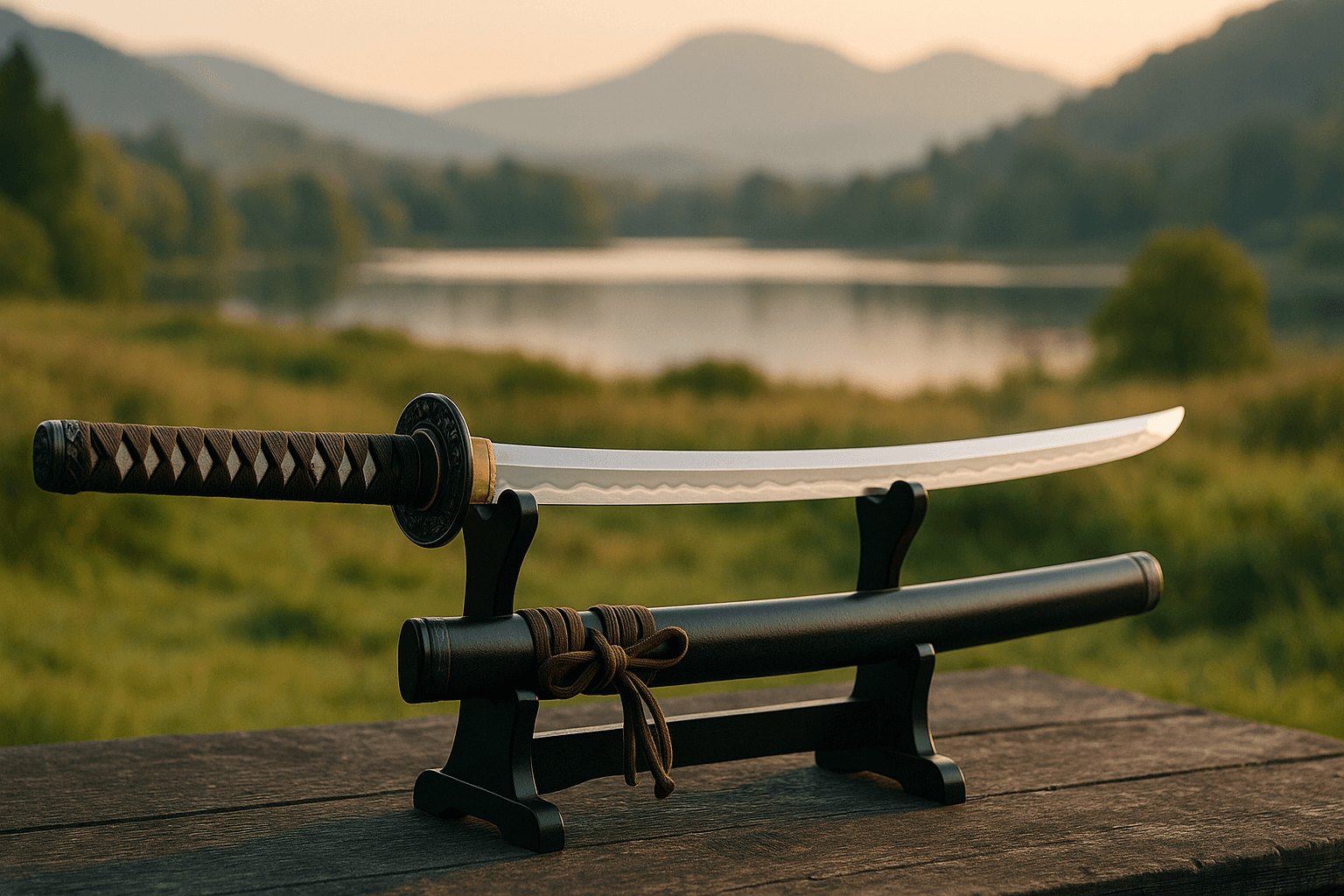Introduction: The Discipline of Preservation
Caring for a katana is more than maintenance. It is an act of respect—respect for the blade, for the smith, and for centuries of tradition. The katana is not merely steel; it holds history, craft, and purpose. Its edge is sharp, but its spirit is deeper.
Preserving a katana demands attention. Every motion—cleaning, oiling, storing—is deliberate. No shortcuts. No distractions. This is a practice akin to kata in the dojo: repetitive, focused, and honoring something greater than the self.
In this article, we explore the discipline of katana care—a path marked by detail, quiet respect, and enduring tradition.
Cleaning Your Katana: A Ritual, Not a Chore
Cleaning a katana is not mere maintenance; it is an expression of respect. Begin in a quiet place and lay out your tools: uchiko powder ball, rice paper or a soft cloth, choji oil, and a clean pad or surface. Wash your hands. Still your thoughts.
First, lift away old oil. Gently tap the blade with the uchiko ball, applying powder across both sides. Wait for a moment, then, using a fresh cloth, wipe from the spine to the edge, base to tip, with one steady stroke—never double back. Repeat this process until the blade is clean.
Inspect the blade in natural light for nicks, rust, or discoloration. Treat small rust spots with care, never with abrasives. Touch the blade only when necessary, and never with bare fingers.
Next, apply choji oil. A drop on a clean cloth is enough; spread it gently and evenly. A thin coat is best—too much oil attracts dust. Conclude the process in stillness. If the sword was dismounted, reassemble it. Mindfully return it to its stand or scabbard.
Properly performed, this ritual preserves more than steel. It sharpens awareness and strengthens presence. Like the blade itself, cleaning demands intentionality—nothing wasted, nothing rushed.
Choosing the Right Oil: Function Over Fragrance
Oil keeps your blade alive, forming a barrier between metal and air. Without it, rust prevails. When selecting oil, prioritize function above fragrance; protection matters most.
Traditionally, sword caretakers use choji oil—a white mineral oil disturbed by a faint clove scent. The scent itself is not significant, but the mineral oil is. Nowadays, pure mineral oil remains a reliable choice: stable, light, and non-sticky.
Modern synthetic oils designed for rust prevention and moisture resistance also perform admirably. Gun or knife oils can be suitable, provided they are safe for long-term use on carbon steel.
Avoid vegetable oils, gun lubricants with solvents, and anything that dries sticky or gummy; these can trap moisture, attract dust, or break down over time, causing corrosion.
Apply oil sparingly—just a few drops on a cloth, wiping the blade evenly before storing it in a dry place. The right oil, used with care, honors the blade and demonstrates discipline and respect.
Proper Storage: Stillness Protects the Edge
A katana rests best in stillness, and every aspect of storage should serve its longevity. Keep the blade dry, as humidity encourages rust. Store the katana in a clean, dry space away from direct sunlight and moisture, ideally maintaining a humidity level between 40–50%. Dehumidifiers or silica gel packets can help maintain this balance.
Always sheath the katana in its saya (scabbard). The saya protects the edge from dust, air, and accidental contact. Before storing, make sure the blade is lightly oiled and free from fingerprints, as natural oils can corrode steel.
Lay the katana with the edge facing up to reduce pressure on the blade, letting gravity favor the hamon rather than strain it. When displayed on a rack, the handle should point to the left—an age-old gesture of tradition and peace.
Display with intention. Avoid frequent touching and keep it away from heat sources, open windows, and vibrations. True preservation comes from stability and thoughtful placement. Let the resting katana reflect the same quiet discipline it carried in motion.
Long-Term Care: Discipline Over Time
Caring for a katana is not a one-off task but a lifelong practice—rooted in rhythm, observation, and respect. Establish a maintenance schedule; once a month is a good guideline, or more often if the blade sees frequent use. Start with clean hands, a clean space, and a clear mind. Prepare your tools, and follow each step with precision.
Before each cleaning, inspect the blade for rust, discoloration, or scratches. Examine the edge for chips. Check the mekugi (bamboo pegs) for tightness and the tsuka (handle) for any looseness—small problems left unchecked can lead to greater damage over time.
Recognize that discipline is protection. While the blade may rest, your attention must not. Even in storage, steel is vulnerable to moisture and neglect. Keep up with oiling, rewrapping, and proper positioning. Store the katana dry, cool, and horizontal, always edge up.
There is quiet power in repetition. A katana kept clean and cared for becomes a mirror of its owner’s focus. Long after the first polish, this discipline weaves itself into the blade’s story—and into your own.
Conclusion: Carrying Legacy Through Action
To care for a katana is to honor centuries of craft and discipline. Its polished blade, oiled and sharp, shines not only with light but with lineage. Every act of maintenance is a silent gesture of respect: cleaning, inspecting, and storing become not only preservation, but promise.
The hands of the guardian become a living part of the sword’s story—not through grand displays, but through steady attention, patience, and intentional action. The katana does not speak, yet it remembers—in its reflection, your reverence and commitment are forever engraved.
Carry the legacy forward—not loud, but with purpose. Let your actions honor both the blade and the tradition it bears.





